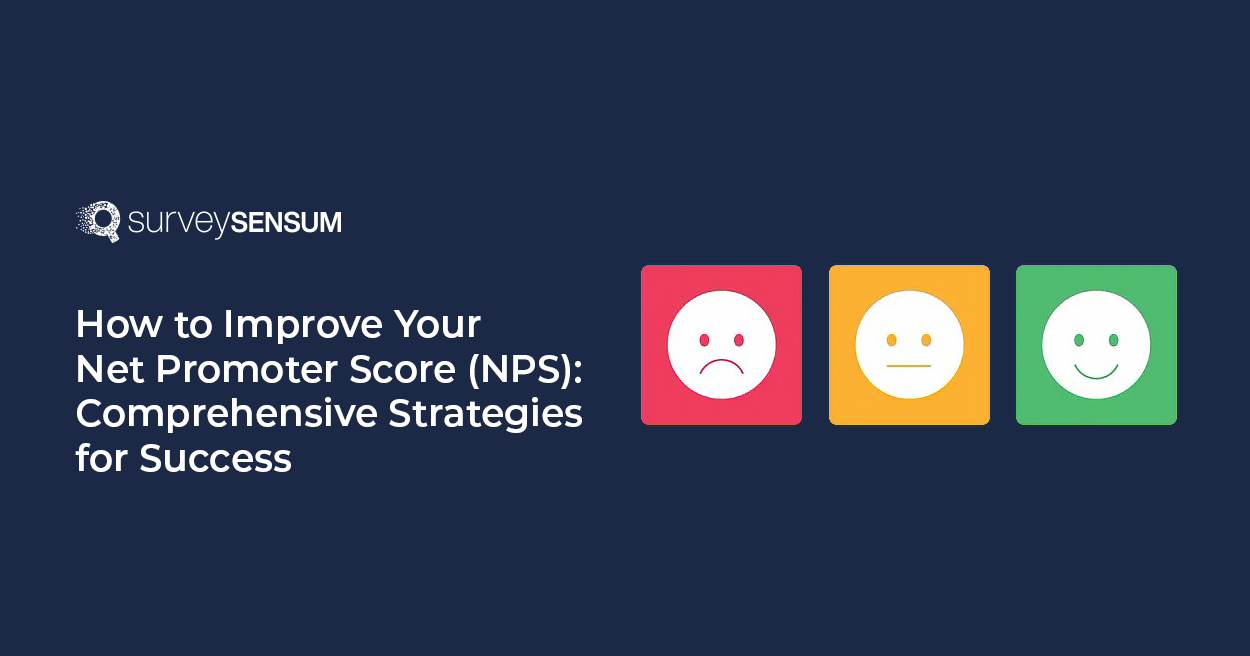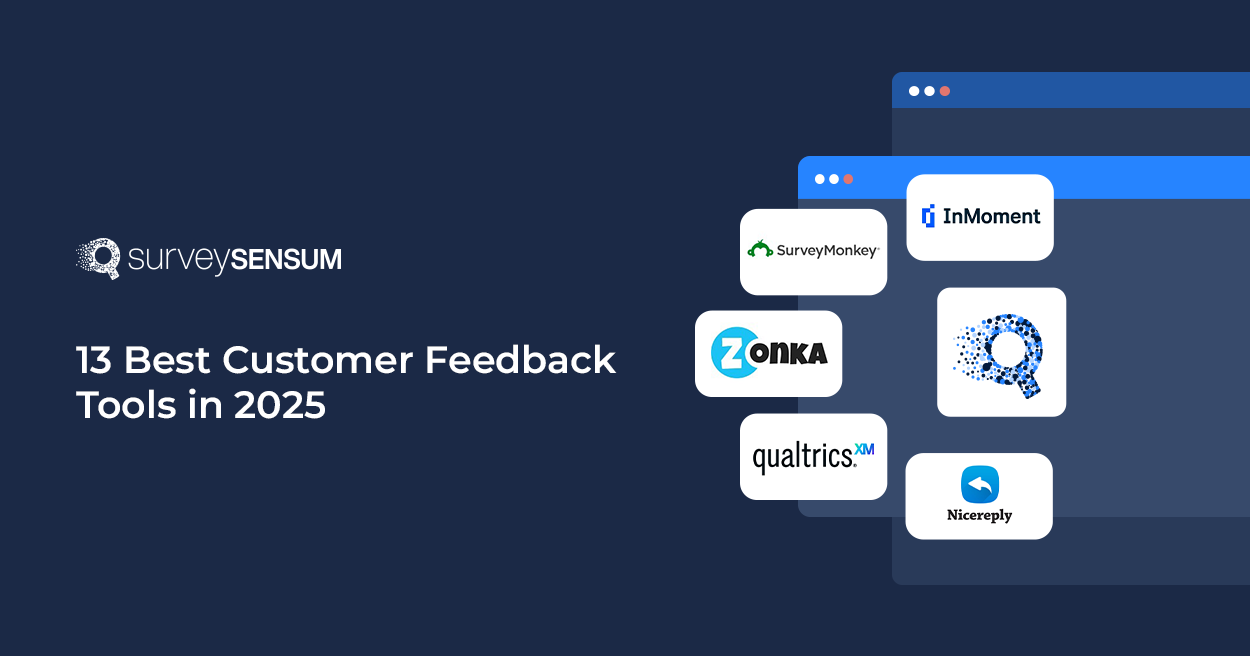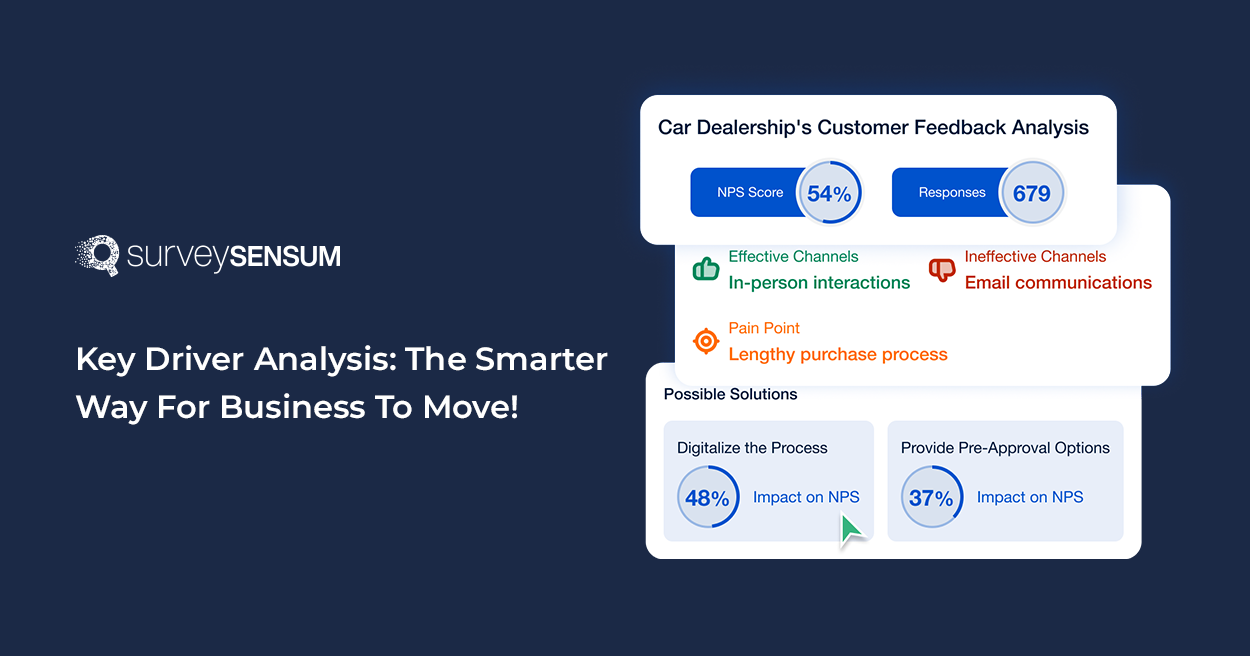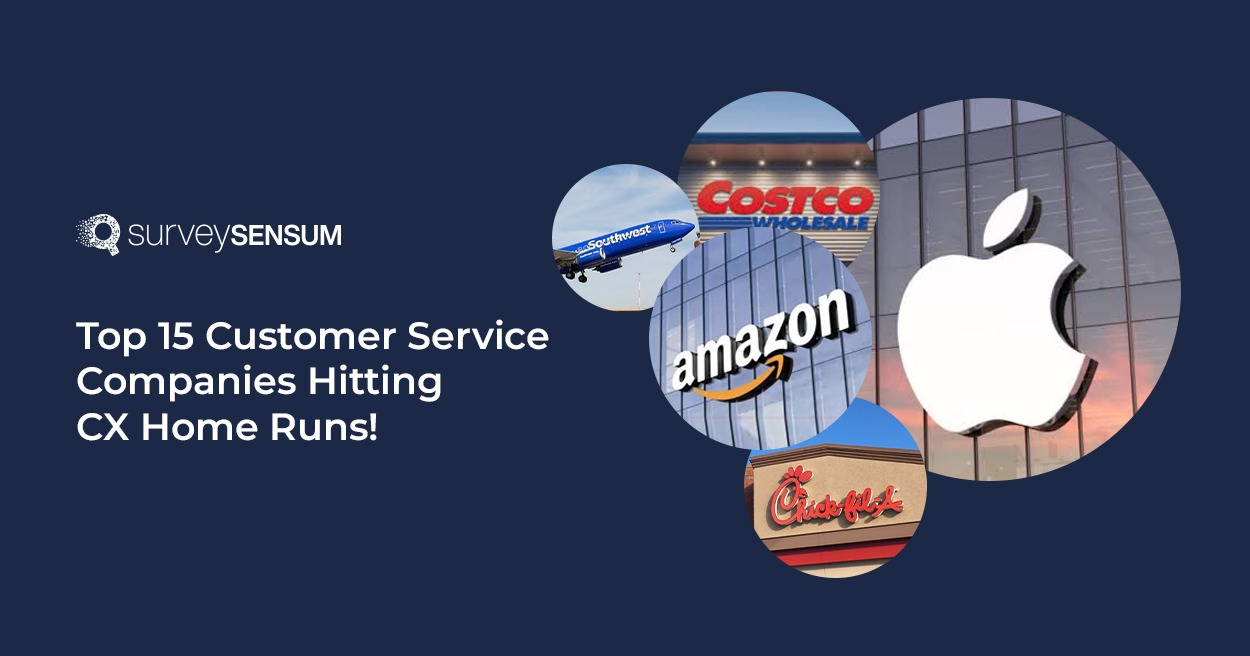
Customer experience has moved from being a competitive differentiator to a key business imperative. Companies that lead in customer experience are now outperforming laggards by nearly 80%.
NPS is a critical business KPI that tells you how likely your customer is to recommend your product or service to others. It is the key predictor for gauging and improving customer retention and loyalty. It helps you identify what is working for you and what is not!
Given its significance, how do you improve your Net Promoter Score?
Did you know that 48% of your unhappy customers are likely to complain about negative experiences with brands to 10 or more people?
How can you convert these unhappy customers into brand advocates or encourage your promoters to do positive word of mouth and bring referrals? How can you increase your customer base, revenue, and customer loyalty?
Let us help you get the answers to all these questions.
Let’s jump right in!
14 Strategies on How To Improve Net Promoter Score (Tried & Tested)
1. Understand Where You Stand
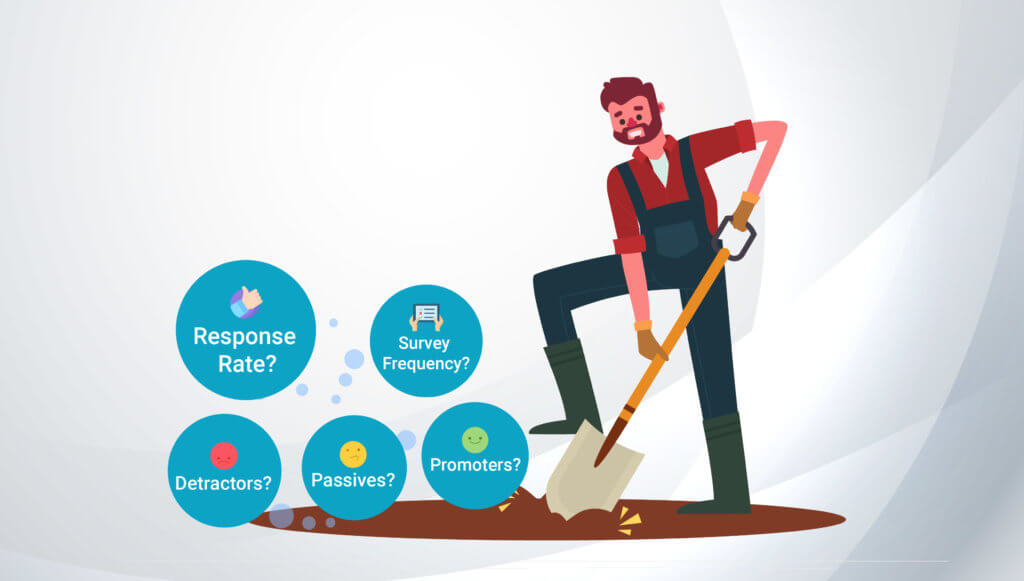
Before improving your NPS, it’s essential to establish a baseline. Knowing where you currently stand allows you to measure progress effectively and understand what’s working and what needs to change. Without a clear starting point, any improvements in NPS lack context, making it difficult to track the true impact of your efforts.
So, understand the structure of the current NPS program.
What is the current response rate? At what frequency are you sending the surveys? When are you sending the NPS surveys? Are you capturing feedback at all the relevant touchpoints/customer interactions handled by multiple teams? Are you asking for feedback from the right people and through the right channel? And at last, are you taking the required action?
Knowing what is happening in your organization and how you are interacting with the detractors, promoters, and passives is really important. Gather this data before moving forward.
So dig in!
2. Set a Realistic Goal

Depending on the size or stage of your organization, the CXO, CMO, CPO, or CCO (whoever is leading the CX initiatives) will call for an executive meeting to involve other stakeholders together with the CEO. This meeting aims to define a realistic NPS goal and align the entire organization toward achieving that.
It is important to define a realistic goal for your company and not just any number. For example, if your current NPS is 30 and you want to take it to 60, is it possible in 3 months? Will you be able to capture, analyze, and take action on tons of feedback in such a short time? No. That’s why it is critical to set a realistic goal for your entire company and each team within.
SurveySensum’s NPS software enables you to set clear NPS goals, track progress in real-time, and make data-driven improvements to enhance customer loyalty.
Define and track NPS goals with SurveySensum that align with your business goals and KPIs to drive prioritized action that impacts your bottom line!
3. Encourage Buy-ins Across Divisions
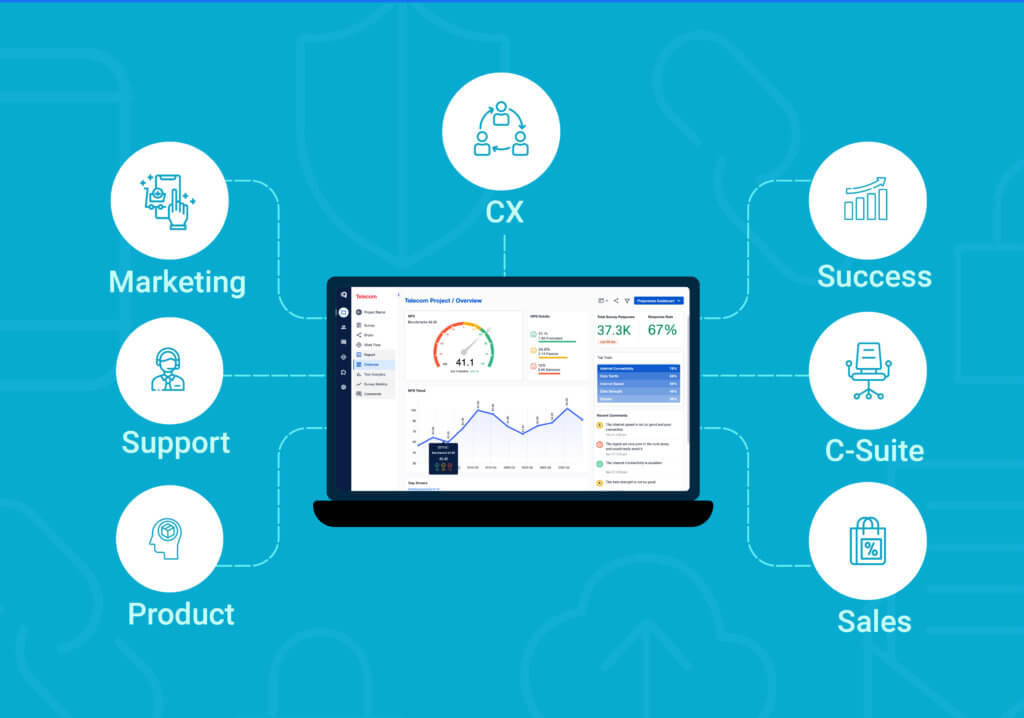
Improving NPS is not a one-man job. The entire organization needs to get on board. Every member of the organization needs to understand why it is important and what they can do to achieve this goal.
But, getting their buy-ins is not easy! That’s why any CX program is driven by the top leadership and the CXO, CCO, or CMO drives it across the organization. They get the team leaders’ buy-in and set the KPI for each department based on the global NPS goal.
4. Set NPS Goals for Each Department

The adoption should be from the top to the bottom. To drive the overall NPS score of the company, you need to drive the NPS for each department. Why?
Because how a CSR treats your customer, how good the quality of the product is, and how responsive the support team is, everything impacts the customer experience. That’s why, NPS is measured at every touchpoint of marketing, sales, product, after-sales, onboarding, support, and renewal.
Also, every department should have a specific target to achieve. Why? Let’s say, the target is 60 for all the departments. The current NPS of the sales team is 50 so it is easier for them to jump to 60. However, the support team’s current NPS is 22, so it is difficult for them to achieve 60. The challenge here is for the CXO to communicate what actions need to be taken by each department to achieve the global NPS goal.
In every QBR meeting, discuss the NPS score for each department. Understand what challenges they are facing and what action needs to be taken to drive the NPS.
Also, not everyone will give you the buy-in, you need to start by prioritizing the journey with the highest impact.
5. Identify the High-Impact Journey
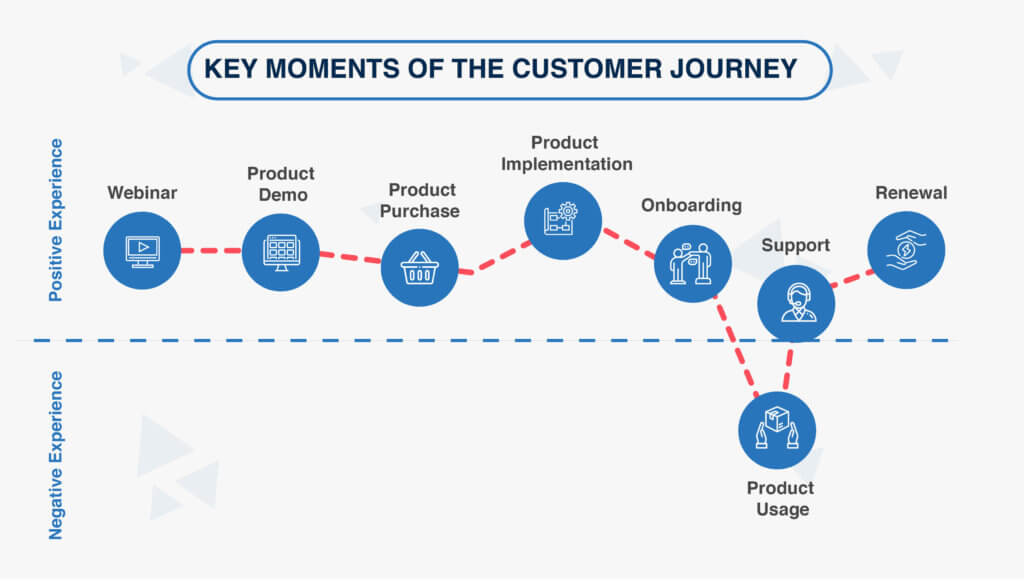
Understanding customer feedback at individual touchpoints won’t help you. To truly understand the root cause of the problem, you need to get the full picture of customer behavior by analyzing the entire customer journey.
Your customers will have different journeys as per the engagement level and touchpoints. Do a comprehensive customer journey mapping to know your buyers’ persona, understand their goals, map out the touchpoints, and identify their pain points.
Identify the journey that is driving the net promoters and net detractors. Find out the key milestones and preferred touchpoints of the customers. Segment them based on your business KPIs such as net revenue, CLV, retention, or churn rate. Identify the key moments where your customers are most unhappy. Prioritize them and create customized strategies to address each issue.
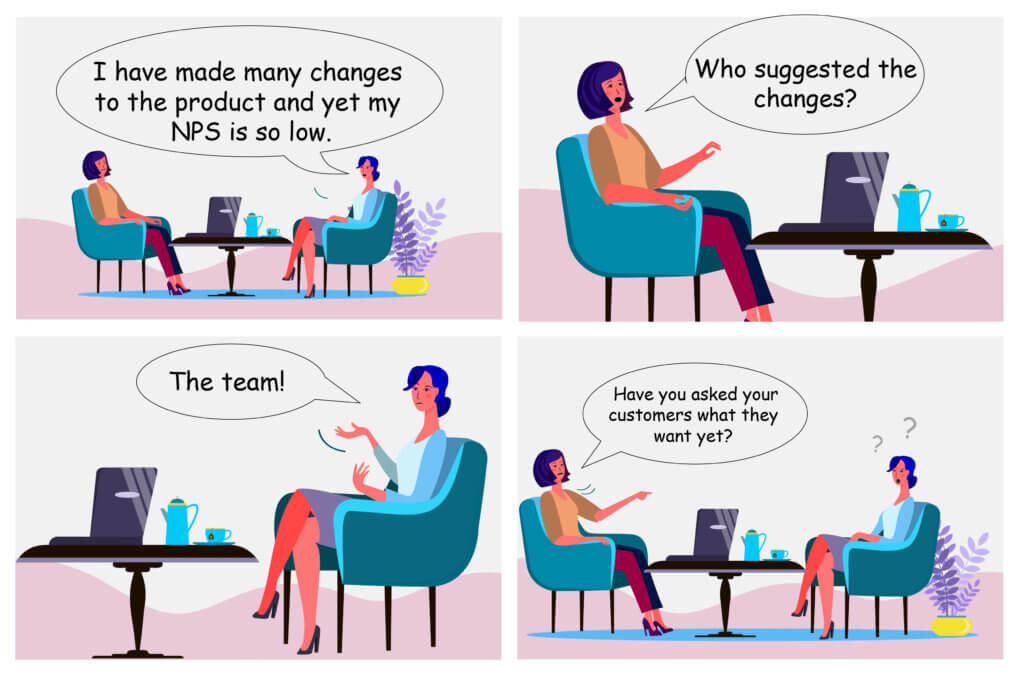
6. Design your CX Program
Now, make an efficient customer-driven plan on how to create adoption and boost Net Promoter Score in the organization. Define the touchpoints to cover the channel of engagement, customer segment, and frequency of the survey.
Design the CX program such that insightful actions can be taken. Create role-based dashboards, and trigger-based notifications so that each feedback will be shared with the concerned teams to take prompt action.
Further, define the plan of action on the feedback that includes the workflow of the action, who’ll lead and review, and what NPS questions will be sent in a survey.
7. Choose the Right Survey Channel
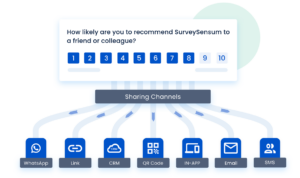
Choosing the right channel is important to improve your NPS score.
While most companies choose emails since it’s easier for them to share the surveys, it’s not always a best practice to do so. There are several other methods to try out, especially WhatsApp surveys.
Connect with your customers through the right channels and increase your NPS response rate, thereby improving your NPS score. Once you have selected the channels it’s time to launch the survey.
8 . Launch the NPS Survey the RIGHT Way To Maximize the Responses

Here’s the ideal way to launch the NPS survey so you receive maximum responses.
STEP 1: Craft a beautiful and personalized NPS survey and white-label the ‘from name’. And remember it needs more than just an NPS pointer scale question.
STEP 2: Send the NPS survey at the right time. Some brands, when they begin taking their customer feedback, send NPS surveys at the wrong time like after a support interaction, which is plain wrong. NPS was built to measure customer perception of the brand, not the interaction. Send the survey when the customer has received enough value from your brand to recommend it to someone.
STEP 3: Send the NPS survey to the right channel. Recognize the channels that your customers prefer. Is it your app, SMS, email, or even WhatsApp? Because you’d be sending the surveys over email while your customers are on WhatsApp. This won’t give you enough response rate to get the actual NPS number.
STEP 4: Never ignore the NPS follow-up question. NPS in itself is just a thermometer that tells you whether you’re sick or not. It has no value if you don’t understand the reason for that number. So look at the verbatim to see where the problem is, and why it is happening so that you can decide what to do about it.
STEP 5: Review your VOC dashboard and analyze the performance of your product or service at all touchpoints. Identify the detractors, passives, and promoters, and go in-depth in the open qualitative feedback to understand the sentiment of the customer and analyze if the problem is in a specific product, service, or channel.
STEP 6: Combine CSAT and CES with NPS in the customer journey. NPS tells you about overall brand loyalty and what creates brand loyalty. When your customers have consistent, high-quality experiences at every interaction in their customer journey.
So when they connect with you over your app or call your support, use CSAT or CES to see what is happening on that touchpoint.
STEP 7: Take action on CSAT/CES data. Now it’s time to improve those interactions where customers are not happy in the customer journey. Set up monthly meetings with stakeholders of those interactions and discuss what you found in the CSAT verbatim and what needs to be done.
STEP 8: Communicate the action plan. Send your customers newsletters, and magazine articles and let them know (You told us X and we Did XX) so they feel that you care.
STEP 9: At last, measure the NPS over time and you will see it rising point by point.
Don’t Just Measure NPS—Improve It! With SurveySensum leverage advanced sentiment analysis and text analytics to instantly decode customer emotions and pinpoint the key drivers behind your NPS score!
Let’s dig in further to understand what you should do with detractors, passives, and promoters to increase the Net Promoter Score.
9. What to Do with the Detractors?
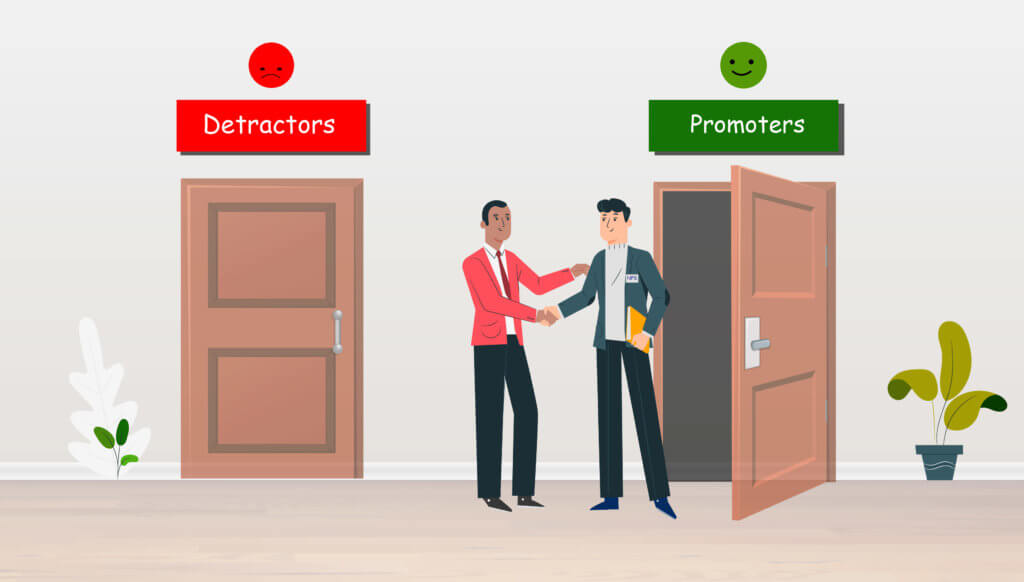
Detractors are critical for your business. They are the product stabilizers! They are the customers who will share honest reviews about your product, find the loopholes in it, and give you opportunities to improve it.
But how can you convert them into promoters?
Here’s how!
Engage with your detractors
Follow-up 1: It is critical to engage with your detractors. Especially after they have given you a low score. Promptly, reach out to them to show them that you care about how they feel.
Follow-up 2: After the first follow-up, identify the themes and understand the issue with your internal teams. Once themes are discussed, the concerned team should follow up with the customers talking about those themes to understand the root cause of the problem and take the required actions.
But how can you do it?
-
Identify themes with Text and Sentiment Analysis
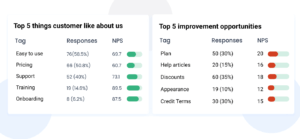
The first step to increasing the Net Promoter Score is to know the problems of your customers and take action on them. To achieve the same, deep dive into the customers’ open responses and run text and sentiment analysis. Create a set of common topics and subtopics related to the product’s offerings, track the sentiment of the customers, identify the themes, and make a plan of action.
Plan a monthly meeting where all the departments discuss and prioritize CX initiatives based on themes identified from the open-ended, verbatim, and decide who will drive the specific initiative, timelines of it, etc.
-
Link NPS with your operational data
Connecting your experience data with your operational data will give you a boost! If you are not doing it, you are not getting the likelihood of improvement in your business.
Your NPS program will yield far more significant insights when you connect your experience data with your operational data residing in your CRM. You can deep dive into the collated data to identify the problem and take action on it.
-
Link NPS with your business KPIs
Link your business KPIs with your NPS programs depending on which stage you are at and what is more important to you; be it churn, retention, or net revenue. Understand detractors at all touchpoints across the channel and prioritize them considering your business outcome.
-
Democratize your NPS data
Your sales, marketing, and support teams are the ones in touch with your customers. Empower them with insightful NPS data. But how can you do it?
Identify common themes from qualitative feedback with sentiment analysis. Prioritize the issues, categorize them based on the departments, and trigger a team notification to take instant action.
-
Empower your front liners

Constant communication with your customers is essential in customer support, as it can make or break your customer experience. Your customer support team engages with customers daily, building relationships and understanding their sentiments.
They should empathize with the customer’s issue, demonstrating patience, knowledge, and a deep understanding of the product. Additionally, they must possess the authority to make instant decisions when needed.
Have you removed the problem from the core?
Don’t communicate the problems on an individual level rather empathize with the customer and get rid of the issue from the core. So, when the respondents revisit your brand, interact with customer service, and see that they have been heard, it will boost their loyalty and trust in you.
-
Deliver the brand value
There is nothing worse than going back on your word. If you promised something to your customer, deliver on it!
Three things motivate your customers to be with you. Functional value, emotional quotient, and social value. To deliver these three, your product needs to stand out against your competitors, your team needs to build emotional value with the customer, and your product needs to thrust their social status.
-
Create Brand Ambassadors

If a customer is reaching out to you for any support at any point or channel, provide them with the help they are seeking. They are making an effort of reaching out and they are unhappy with your product. It is imperative to provide them with the solution right then and there.
This is a simple and effective way to create brand ambassadors and increase the Net Promoter Score. You are giving your customers the solution and satisfying their needs right then and there. They will be more than happy. And if resolved properly, you have turned a detractor into a promoter successfully and may have created a brand advocate!
-
Close the loop and take action on detractors

The next step after following up with your detractors is to take the required action on their feedback. Make sure you inform them that you have resolved their problem.
By closing the loop, you acknowledge customer concerns, resolve issues, and show them their voice matters. A well-structured closed-loop system ensures that detractors turn into promoters by addressing their pain points swiftly and effectively.
The most relevant step of all, this will not only convert your detractors into promoters but also create brand advocates.
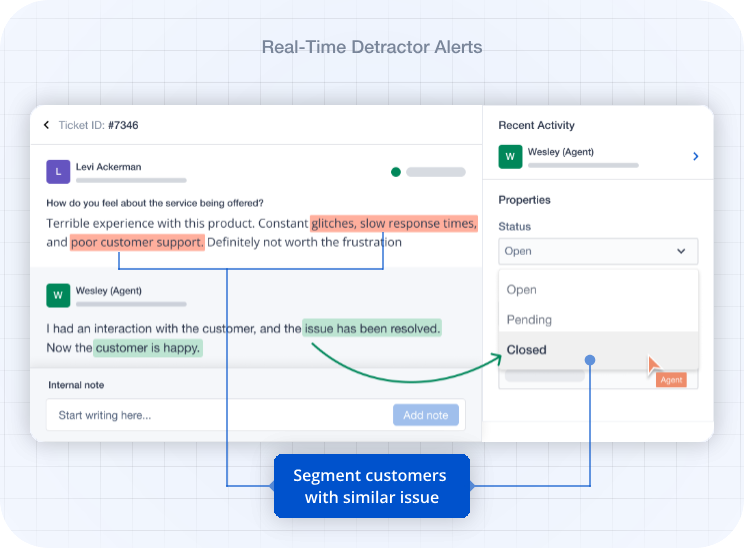
SurveySensum’s AI-enabled real-time ticketing management system, enables you to close the feedback loop and take proactive action in real-time. Every piece of detractor feedback is instantly flagged and escalated to the right team automatically and you can also see your ticket trends to determine resolution time, remaining open tickets, etc.
10. What to do with the Passives?
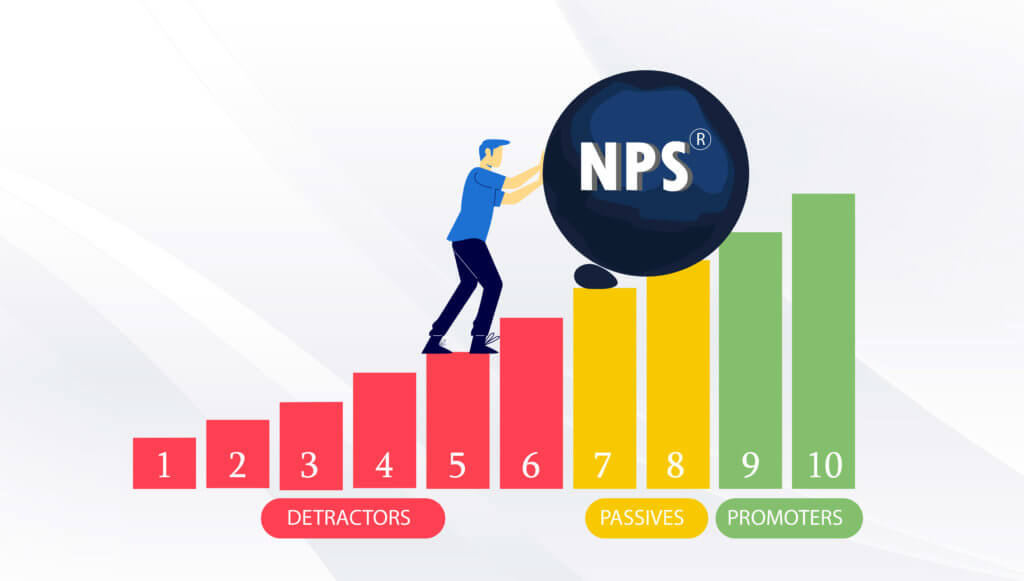
Converting passives into promoters is a two-fold process.
- One, if their NPS is neutral and they haven’t shared any qualitative responses, reach out to them and understand their issues.
- Second, if they have given qualitative responses, treat them as a detractor. Do everything you do for a detractor. Even some brands treat anyone scoring below 9 as a detractor.
Focus on the % of passives you are getting. If the number is really low compared to the detractors and promoters, it is okay. Focus on the detractors. If not, understand their segment, and their problems, and take all the actions that you are taking on detractors.
11. What to do with the Promoters?

You have 500 promoters, but only 200 give you qualitative feedback, only 100 tell you the issues in your product and only 50 refer you to others. How do you categorize them? How can you create a plan of action if you don’t know how loyal or satisfied your promoter is with your brand?
Here’s how you can do it!
You can categorize your promoters into four different categories, according to different types of NPS.
- Admirer: These are the promoters that will only give you quantitative feedback and not qualitative feedback.
- Loyalists: These are the promoters who will give you both quantitative feedback and qualitative feedback. They will share insights with you to help your product improve.
- Fans: These are the promoters who will do positive word of mouth for you and bring referrals.
- Followers: They are brand followers. They are the true promoters and will stick with you through thick and thin.
Keep your promoters happy. They can offer a lot of valuable insights into what you are doing well and should continue to do. They give you innovative ideas and business opportunities.
12. Non-Respondents

Non-respondents are the most important yet most ignored segment that NPS does not include. They are the customers who did not respond to your surveys and are highly likely to churn. So what should you do?
You need to evaluate your customers. If you have any high CLV customers who are not responding to your surveys, treat them as more than a detractor. Call them up personally and understand their problem. There is nothing better than a one-to-one call to help get more responses.
TIP: An efficient NPS software helps you create NPS surveys and launch them at the right touchpoint and at the right time. Also, the tool helps share alerts to the team when a detractor shares their feedback and analyzes all the feedback. Not only does it help you close the loop in time, but it will also help you create an efficient NPS program.
13. Identify Key NPS Drivers

The biggest challenge with NPS driver analysis is that businesses don’t know how to identify what are these drivers, which KPIs to track to improve their NPS, how to create a robust dashboard, how to do impact analysis to prioritize action, and how to study their dashboards to understand the state of the NPS.
SurveySensum’s Text Analytics streamlines this process. It leverages AI to identify the key drivers – enabling you to prioritize them based on their impact on customer satisfaction and loyalty.
Additionally, it also enables you to run ad-hoc surveys from the same platform to gain specific insights into critical areas such as customer churn, drop-off, product satisfaction, and others so that you can address these specific issues and improve customer retention.
14. Avoid NPS Gaming
One of the biggest challenges in NPS measurement is NPS gaming—when employees or teams manipulate scores to make the results appear more favorable. While a high NPS is desirable, artificially inflating scores by influencing customer responses leads to inaccurate insights and prevents meaningful improvements. To truly enhance customer loyalty, businesses must ensure that NPS feedback remains authentic, unbiased, and actionable.
Some effective ways to avoid NPS gaming are:
- Avoid having employees directly influence customers’ responses.
- Centralize and automate communication with customers about surveys to prevent intentional gaming.
- Emphasize the importance of the feedback loop process over the NPS score itself. Also, involve higher-level management and executives in closing the loop process.
- Foster an environment where customers feel comfortable sharing open and honest feedback.
- Enhance employees’ understanding of the significance of NPS as a strategic tool for evaluating customer satisfaction and loyalty.
- Clearly communicate that threats or bribes related to survey responses are unacceptable.
Discourage the practice of making customers feel guilty about their survey responses.
Say goodbye to guesswork and hello to data-driven CX strategy and optimize your customer experience with SurveySensum’s AI-enabled NPS software!
Let’s now discuss some challenges of implementing NPS.
Challenges and Factors Affecting NPS
Challenges in Improving NPS
Improving NPS isn’t just about sending surveys and analyzing scores—it requires strategic efforts, cross-functional alignment, and customer-centric initiatives. Here are some key challenges businesses face:
- Low Response Rates: Many customers ignore surveys, making it difficult to gather a representative sample of feedback.
- Lack of Actionable Insights: Collecting feedback is easy, but interpreting and acting on it effectively can be a challenge.
- Customer Expectations Keep Rising: With increasing competition, customers expect seamless, hyper-personalized experiences, making it harder to exceed expectations.
- Internal Silos: Without alignment between customer support, product teams, and marketing, implementing feedback-based changes becomes slow and inefficient.
- Negative Word of Mouth: Dissatisfied customers are more likely to share their experiences publicly, which can hurt brand reputation and deter new customers.
Factors that Impact NPS
Several internal and external factors influence NPS, shaping customer perceptions and their likelihood of recommending a brand. Key factors include:
- Product Quality & Innovation: A high-quality, reliable product with innovative features enhances customer satisfaction and drives higher NPS.
- Customer Service Experience: Prompt, empathetic, and efficient customer support plays a crucial role in turning detractors into promoters.
- Pricing & Value Perception: If customers feel they’re getting value for money, they are more likely to recommend your brand.
- Ease of Use & Accessibility: A seamless user experience – whether in-app, website, or in-store – directly impacts customer loyalty.
- Personalization & Engagement: Tailoring experiences based on customer preferences makes them feel valued and boosts their likelihood to promote your brand.
- Competitive Landscape: NPS is also influenced by how competitors are performing – if they offer superior experiences, your scores may drop even if nothing changes internally.
Conclusion
The Net Promoter Score is an extremely valuable CX metric that can redefine your customer experience if used correctly. The deep insights it provides help a lot in ideating strategies to increase customer loyalty, drive customer base, and increase revenue.
It not only helps you gauge customer satisfaction and loyalty but also helps you identify ways to improve, prioritize reaching out to the detractors, and boost referral marketing. And as you know referred customers have a 16% higher lifetime value and ROI than others. So, improving NPS continuously is more like a necessity.
So, focus on building great customer experiences that create promoters to reach the same level as companies like Costco, Apple, Dillard’s, Amazon, and Southwest Airlines whose NPS scores are above 70.
And if you have detractors, you now know what to do! 🙂






